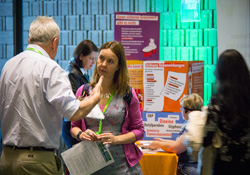Day 2 of Environment and Health Conference: Addressing inequalities, good governance, rights and resilience

WHO
On the second day of the Sixth Ministerial Conference on Environment and Health, participants explored the role of communities and national and regional authorities in strengthening resilience. Discussions focused on the global relevance of environment and health policy in Europe and changing patterns of consumption.
Plenary session 4: Resilient communities in supportive urban environments
Opening the session on community resilience, Ivo Vondrák, Governor of the Moravian-Silesian Region, explained that the area has historically experienced high air pollution levels, but recent years have shown marked improvement. He described how keeping young people from leaving, and preventing “brain drain” is an essential component of smart regional development, thus investment in universities and their graduates stimulates development in a region.
A panel discussion explored some of the national initiatives taken by Member States, and emphasized the importance of building better disaster resilience infrastructure by creating synergies with disaster risk reduction and climate change strategies. In conclusion, Dr Zsuzsanna Jakab, WHO Regional Director for Europe, emphasized the need for cities to have a sustainability plan, and expressed the hope that the Ostrava Declaration will help in this regard.
Plenary session 5: Maximizing the benefits for people of international and national environment and health policies
Opening the session, Dr Piroska Östlin, Director of the Division of Policy and Governance for Health and Well-being at WHO/Europe introduced the human rights dimension in her presentation on engaging citizens to improve environment, health and well-being. She underlined how political commitment to inclusive governance can result in a more transparent, just and equitable process of evidence-based policy-making. This process needs to be based on public access to information and community empowerment, as well as social and environmental justice.
The theme of human rights as a promoter of sustainability and innovation was explored further by Baskut Tuncak, United Nations Special Rapporteur on Chemicals and Human Rights, in the subsequent panel discussion. Tomáš Macura, Lord Mayor of Ostrava, and Karsten Uno Petersen, representing the European Committee of the Regions emphasized the role of national, subnational and municipal administrations and the need to “think global but act local”. As the average age of parliamentarians is 53, the opportunity for youth engagement in policy-making and legislation is limited, noted Antonio Marques Pinto of the European Environment and Health Youth Coalition (EEHYC). The EEHYC was established to give young people a voice and mechanism for engagement in environment and health policy-making.
Génon K. Jensen from the Health and Environment Alliance (HEAL) highlighted their collaborative work with citizens and civil society through the EDC-Free Europe coalition and their landmark report the Unpaid Health Bill. She encouraged national governments to increase protection for vulnerable groups, particularly children.
Plenary session 6: Global relevance and impact of environment and health policies in Europe
According to Dr Maria Neira, WHO Director, Department of Public Health, Environmental and Social Determinants of Health, 92% of people breathe poor quality air, and 4.3 million deaths per year are due to ambient air pollution. Dr Neira also reiterated the significance of population growth in policy development: the global population is projected to reach 9.7 billion by 2050, of which 70% are expected to live in urban areas. Such global environmental challenges also offer opportunities for action, particularly with respect to implementing the Sustainable Development Goals (SDGs). Environment and health priorities underline that WHO must take action across the SDGs, rather than focusing on SDG 3, the explicit health goal. International agreements can be used to support progress, such as the Paris Agreement on climate change, which has the potential to be the most important global public health treaty.
Panel discussions emphasized the need for intersectoral action and collaboration. Responding to examples from other WHO regions, delegates noted the commonalities in the problems faced by the different regions. This strengthened the call to work together more, including and engaging with civil society and communities, to tackle environment and health issues, especially those of global consequence, such as climate change.
Plenary session 7: Exploiting less and producing more: economy of environment, health and well-being
This final session for day 2 revolved around three main areas: economic consequences of the health impacts of environmental risks; health aspects of sustainable production and consumption; and opportunities that collaborative/circular economy, sustainable procurement, and environmental sustainability offer health systems. In her keynote presentation, Anja Leetz, Health Care Without Harm, reiterated the impact of air pollution on health, as well as the need to reduce exposure to chemicals and biological agents, especially those that have a higher impact on child health, such as mercury, endocrine-disrupting chemicals and persistent organic pollutants. Furthermore, all health and societal policy should be evaluated on costs and benefits; such benefits should also include mortality and morbidity avoided, and this is currently not done, she explained.
The panel discussion that followed highlighted the opportunities and challenges of integrating health in the implementation of green and circular economy principles and policy. A few experiences and examples of supportive initiatives were presented, such as the energy-saving hospitals initiative in Germany. In conclusion, the moderator Dr Hans Kluge, Director of the Division of Health Systems and Public Health at WHO/Europe, summarized that policy-makers need to estimate the costs of inaction, work more closely with ministries of finance and health insurance providers, and encourage health systems to lead the way in reducing their environmental footprint.
Side events
Five side events took place on day 2, covering: the Transport, Health and Environment Pan-European Programme (PEP), cleaner air for healthier lives, elimination of asbestos-related diseases, health at the heart of urban development strategy, and environmentally sustainable health systems. At the latter, the WHO/Europe publication “Environmentally sustainable health systems: a strategic document” was launched.



